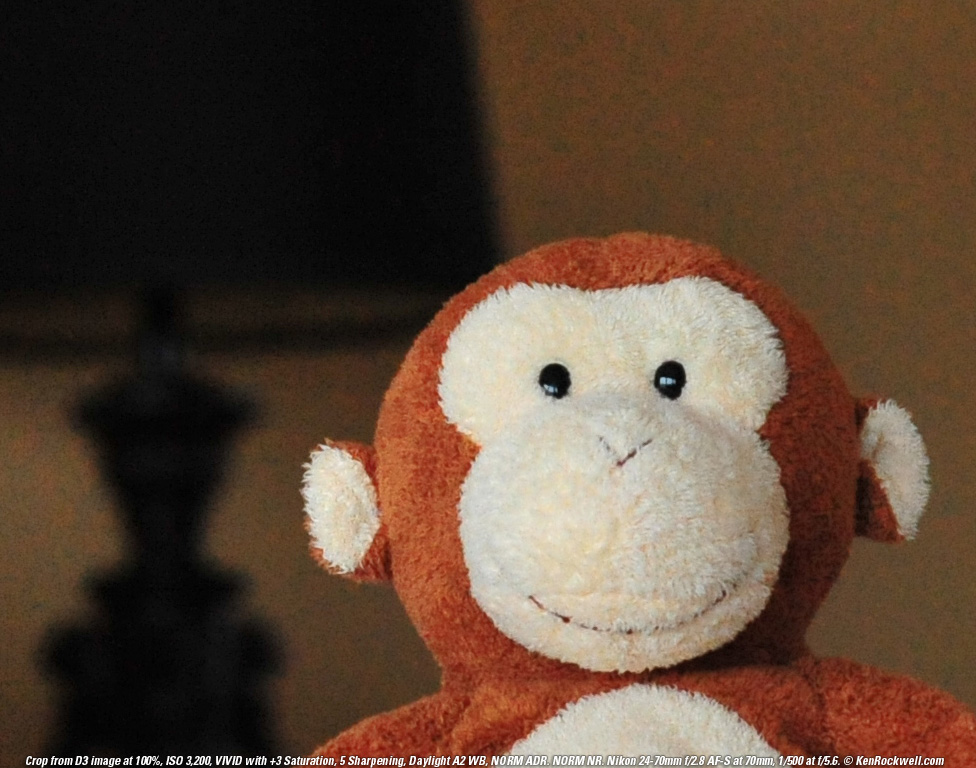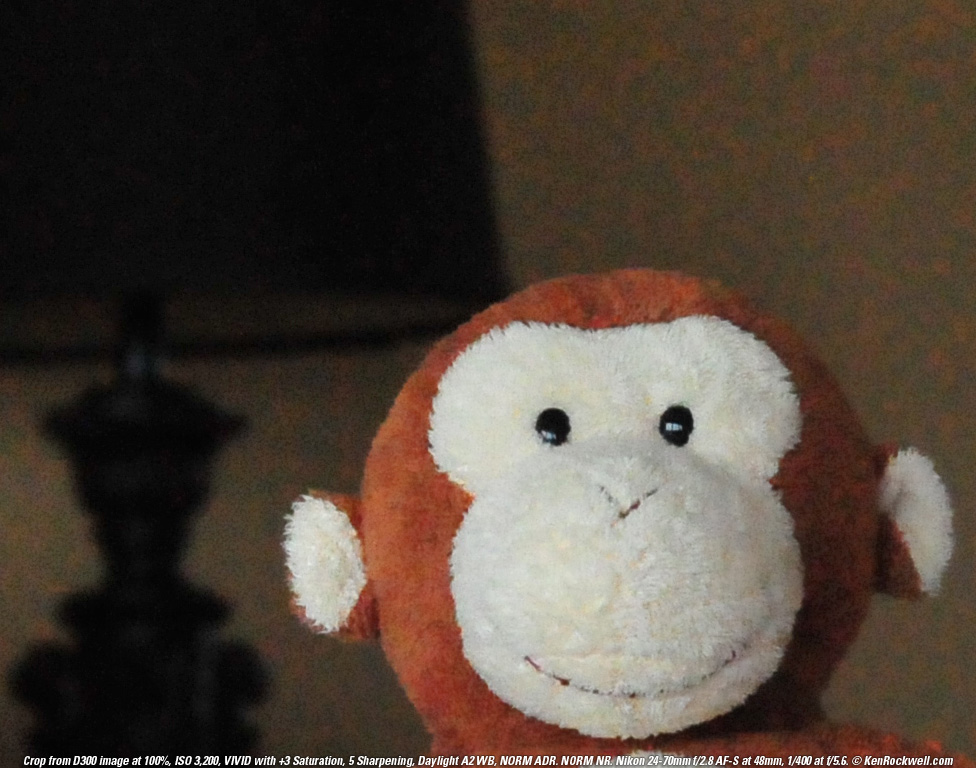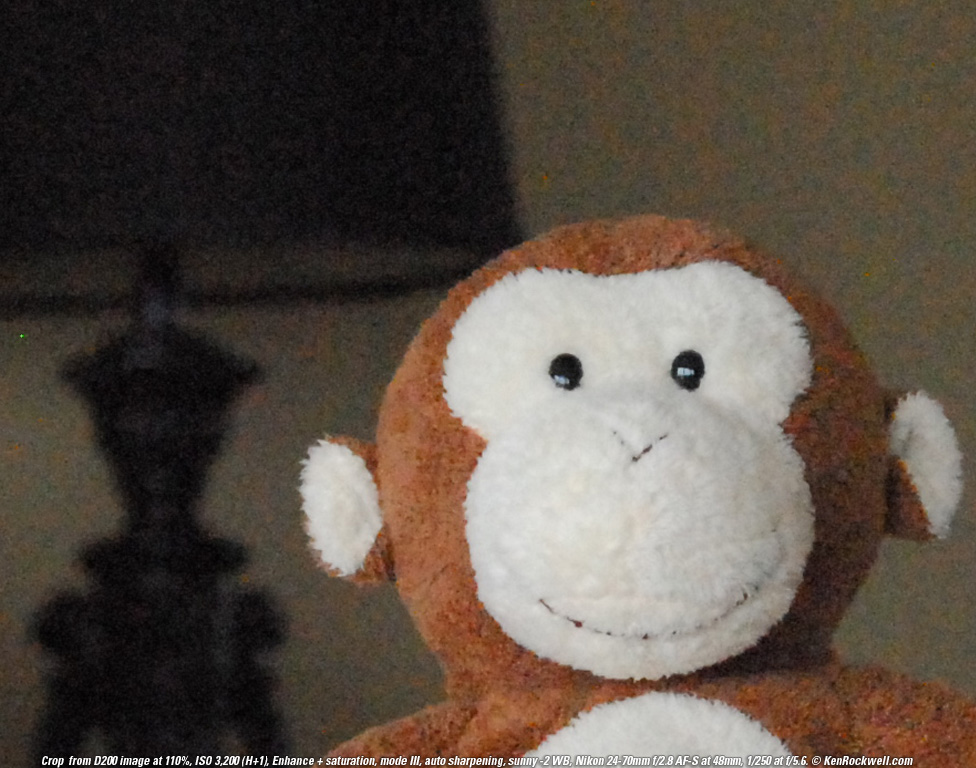Home New Search Gallery How-To Books Links Workshops About Contact
Nikon D3, D90, D300 and D200 September 2008 More Nikon Reviews Nikon D3 Review Nikon D90 Review Nikon D300 Review Nikon D200 Review NEW: Nikon D90 iPod and iPhone App.
As we say in racing, the BS stops when the green flag drops. Let's see which camera does what. This is a very deliberate test. The monkey shows us how much detail and sharpness is left in after noise reduction smudges over the image in its attempts to reduce noise. Any camera can eliminate noisy backgrounds, the hard part is finding a camera which can smooth noise without making everything soft. An even more important thing is how much sensitivity varies between cameras. All because a camera is set to ISO 3,200 doesn't mean that it really is as sensitive as it should be. Another way to cheat is to label something as ISO 3,200, but if it's really only ISO 2,500, the camera will test much better when tested by inexperienced people who simply dial in 3,200 and trust it. More important still is how well a camera preserves color, highlight and shadow. It's easy to go fast in black and white, but hard to retain vivid color and tone. Another trick camera makers use to squeeze high ISOs out of cameras is to mute the color saturation, which hides chroma noise.
Analysis back to top D3 As expected, the bigger-format D3 is the best. It's the cleanest, and more importantly, retains the most natural detail. The D3 is also the most light sensitive: I shot at 1/500 and got the same exposure as the D90 and D300 set at 1/400. The D3 is 1/3 stop faster than the D90 and D300 when set to the same high ISO. D90 The D90 is second best. The D90 has much more noise in the background, and pleasantly, it retains what looks like plenty of sharpness and real, live texture in the subject. The D90 seems a tweak oversharpened in the highlights, while that the darker right side of Mr. Monkey is actually noise, and not monkey fur texture. Look at the random pattern of dark spots in the darker fur, not seen in the D3 example. The D90 is doing a superb job of trying to fool our eyes while carefully alternating between real texture and random noise. I wouldn't mind this, so long as the background noise levels are OK. D300 The D300 is next to last. D300 images at ISO 3,200 don't look noisy, but they do reduce a lot of the resolution and look more like an image from a point-and-shoot as opposed to a real, living clean image like what you get from the D3 and D90. The D300 has about the same middle-frequency and chroma noise, but has smudged over all the fine monkey fur texture. The D300 image looks OK, until you compare it with the real texture in the D90 image. Much of what looks like fur in the D300 image is actually colored random noise. The D300 image has also lost color and vibrancy compared to the D90 and D3. Looking at exposure, the D300 isn't quite as sensitive as the D90; the D300 is slightly darker. At ISO 3,200 you're making excuses with the D300, while the D3 still looks great. The D90 is in between these two. D200 The D200 is the worst. It's as noisy as the other DX cameras, has some hot pixels, and has the least retained detail. It looks terdly, but some of this is because it has less saturation to begin with since it has only Gen 1 image adjustments. Not only this, but the D200 is cheating when set to ISO 3,200, called "High +1.0." I had to use a 1/250 second exposure to get less than I got at 1/500 on the D3 or 1/400 on the D90 and D300. The D200, looking crappy enough set to ISO 3,200, is less than half as sensitive to light as the D3 set to 3,200. Looking at these results, I could set the D3 to about ISO 1,400, the D90 to ISO 1,800, or the D300 to ISO 2,000 to be as sensitive to light as the D200 set to ISO 3,200. If you set these other cameras to those slower values, they would look even better compared to the D200 for the same exposure.
Technik back to top These are crops from the center of each image. The full image at this magnification would print over 40 inches (1 meter) wide. The D200 image was scaled slightly to match the others since it has slightly less resolution. Daylight A2 WB. Sharpening set to 5, saturation set to +3. ADR set to NORM for D3 and D300, set to AUTO in D90. D200 set as shown, no ADR. Nikon Zoom-NIKKOR 24-70mm f/2.8 AF-S set to f/5.6 and zoomed for equal framing. This lens, as do most lenses at f/5.6, has far more resolving power than any of these cameras.
PLUG I support my growing family through this website. If you find this as helpful as a book you might have had to buy or a workshop you may have had to take, feel free to help me continue helping everyone. If you've gotten your gear through one of my links or helped otherwise, you're family. It's great people like you who allow me to keep adding to this site full-time. Thanks! If you haven't helped yet, please do, and consider helping me with a gift of $5.00. The biggest help is when you use any of these links when you get anything. It costs you nothing, and is this site's, and thus my family's, biggest source of support. These places always have the best prices and service, which is why I've used them since before this website existed. I recommend them all personally. Thanks for reading!
Ken |
Home New Search Gallery How-To Books Links Workshops About Contact




